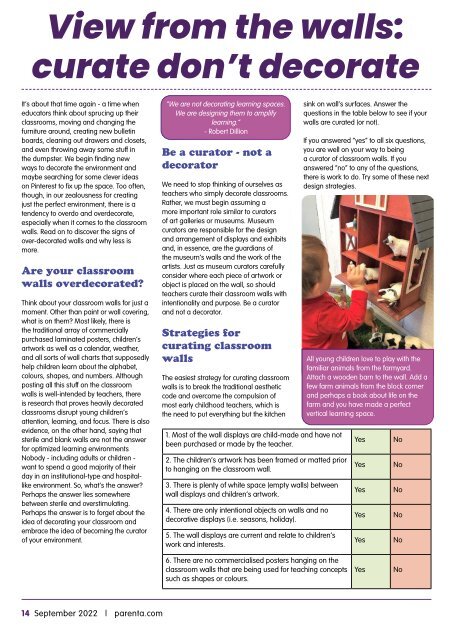September 2022 Parenta magazine
You also want an ePaper? Increase the reach of your titles
YUMPU automatically turns print PDFs into web optimized ePapers that Google loves.
View from the walls:<br />
curate don’t decorate<br />
It’s about that time again - a time when<br />
educators think about sprucing up their<br />
classrooms, moving and changing the<br />
furniture around, creating new bulletin<br />
boards, cleaning out drawers and closets,<br />
and even throwing away some stuff in<br />
the dumpster. We begin finding new<br />
ways to decorate the environment and<br />
maybe searching for some clever ideas<br />
on Pinterest to fix up the space. Too often,<br />
though, in our zealousness for creating<br />
just the perfect environment, there is a<br />
tendency to overdo and overdecorate,<br />
especially when it comes to the classroom<br />
walls. Read on to discover the signs of<br />
over-decorated walls and why less is<br />
more.<br />
Are your classroom<br />
walls overdecorated?<br />
Think about your classroom walls for just a<br />
moment. Other than paint or wall covering,<br />
what is on them? Most likely, there is<br />
the traditional array of commercially<br />
purchased laminated posters, children’s<br />
artwork as well as a calendar, weather,<br />
and all sorts of wall charts that supposedly<br />
help children learn about the alphabet,<br />
colours, shapes, and numbers. Although<br />
posting all this stuff on the classroom<br />
walls is well-intended by teachers, there<br />
is research that proves heavily decorated<br />
classrooms disrupt young children’s<br />
attention, learning, and focus. There is also<br />
evidence, on the other hand, saying that<br />
sterile and blank walls are not the answer<br />
for optimized learning environments<br />
Nobody - including adults or children -<br />
want to spend a good majority of their<br />
day in an institutional-type and hospitallike<br />
environment. So, what’s the answer?<br />
Perhaps the answer lies somewhere<br />
between sterile and overstimulating.<br />
Perhaps the answer is to forget about the<br />
idea of decorating your classroom and<br />
embrace the idea of becoming the curator<br />
of your environment.<br />
“We are not decorating learning spaces.<br />
We are designing them to amplify<br />
learning.”<br />
- Robert Dillion<br />
Be a curator - not a<br />
decorator<br />
We need to stop thinking of ourselves as<br />
teachers who simply decorate classrooms.<br />
Rather, we must begin assuming a<br />
more important role similar to curators<br />
of art galleries or museums. Museum<br />
curators are responsible for the design<br />
and arrangement of displays and exhibits<br />
and, in essence, are the guardians of<br />
the museum’s walls and the work of the<br />
artists. Just as museum curators carefully<br />
consider where each piece of artwork or<br />
object is placed on the wall, so should<br />
teachers curate their classroom walls with<br />
intentionality and purpose. Be a curator<br />
and not a decorator.<br />
Strategies for<br />
curating classroom<br />
walls<br />
The easiest strategy for curating classroom<br />
walls is to break the traditional aesthetic<br />
code and overcome the compulsion of<br />
most early childhood teachers, which is<br />
the need to put everything but the kitchen<br />
1. Most of the wall displays are child-made and have not<br />
been purchased or made by the teacher.<br />
2. The children’s artwork has been framed or matted prior<br />
to hanging on the classroom wall.<br />
3. There is plenty of white space (empty walls) between<br />
wall displays and children’s artwork.<br />
4. There are only intentional objects on walls and no<br />
decorative displays (i.e. seasons, holiday).<br />
5. The wall displays are current and relate to children’s<br />
work and interests.<br />
6. There are no commercialised posters hanging on the<br />
classroom walls that are being used for teaching concepts<br />
such as shapes or colours.<br />
sink on wall’s surfaces. Answer the<br />
questions in the table below to see if your<br />
walls are curated (or not).<br />
If you answered “yes” to all six questions,<br />
you are well on your way to being<br />
a curator of classroom walls. If you<br />
answered “no” to any of the questions,<br />
there is work to do. Try some of these next<br />
design strategies.<br />
All young children love to play with the<br />
familiar animals from the farmyard.<br />
Attach a wooden barn to the wall. Add a<br />
few farm animals from the block corner<br />
and perhaps a book about life on the<br />
farm and you have made a perfect<br />
vertical learning space.<br />
Yes<br />
Yes<br />
Yes<br />
Yes<br />
Yes<br />
Yes<br />
No<br />
No<br />
No<br />
No<br />
No<br />
No<br />
BE A CURATOR<br />
Design strategies for<br />
classroom walls<br />
Honour children’s work. Curators<br />
honour and cherish the work of artists.<br />
Honour children’s work by framing and/<br />
or matting their art.<br />
Find inexpensive frames at a garage<br />
sale, recycle shop, or ask parents for<br />
frame donations. Although it doesn’t<br />
matter what size, shape, or the material<br />
(i.e. wood, metal), it might help to spray<br />
paint the found frames all one colour for<br />
visual aesthetics when they are hung on<br />
the wall.<br />
Less is more. Children have not gained<br />
the skill of “filtering out” so overdecorated<br />
walls are overwhelming to the young<br />
brain. Children just do not know where<br />
their eyes should land, which sometimes<br />
results in negative behaviours. Decide<br />
on what percentage of the wall space<br />
should be covered with stuff and then<br />
stick to it. Instead of continuing to expand<br />
the amount of stuff on the walls, make<br />
it a self-imposed rule to take down<br />
something every time something new<br />
is added to the wall. And don’t forget<br />
that plenty of white space between wall<br />
displays is best.<br />
Conclusion<br />
For more information on vertical<br />
learning spaces, go to Community<br />
Playthings at https://www.<br />
communityplaythings.com/resources/<br />
articles/2019/Vertical-Learning-with-<br />
Classroom-Walls<br />
Clear the palette. If the walls are<br />
cluttered with all types of random stuff,<br />
it’s time to clear the palette, which means<br />
taking everything off the walls and before<br />
replacing, ask yourself:<br />
- Is it child-made?<br />
- Does it reflect current happenings in the<br />
room?<br />
- Is it framed?<br />
If the answer is “no” to any of these<br />
questions, consider the trash basket<br />
for useless stuff and/or make it worthy<br />
enough to display by matting or framing<br />
the children’s artwork.<br />
Close the early childhood catalogue.<br />
Young children’s environments should<br />
reflect those who live within the space<br />
and not look like it came from the pages<br />
of a catalogue. Reduce laminated and<br />
commercially purchased posters. This<br />
is important to do because laminated<br />
posters produce a glare under the harsh<br />
fluorescent lights, which some children<br />
(especially those with sensory disorders)<br />
find intolerable. Another idea is to give<br />
children ownership in the classroom<br />
by providing opportunities for them to<br />
contribute to the décor. For example,<br />
have children make an alphabet chart by<br />
forming letters of the alphabet using thin<br />
and flexible sticks and florist tape.<br />
It’s been said that no one thinks their classroom is overdecorated. If this is true, we have<br />
a big problem because without even being aware of it, teachers are unintentionally using<br />
valuable wall space for insignificant materials. Teaching concepts from commercial posters<br />
that are posted on the wall (for months and months on end), for example, is an ineffective<br />
pedagogy because we all know children learn from hands-on and three-dimensional<br />
experiences. What good, then, is a single dimension poster? You would be better off if<br />
all the “learning” posters were removed from the wall and, in their place, create vertical<br />
learning spaces. Please see the images around the article of some ideas to get you<br />
started.<br />
For toddlers and twos, attach PVC piping to the wall with metal clamps and provide<br />
soft balls for children to drop into the holes and predict where they will emerge.<br />
Sandra Duncan<br />
Sandra works to assure the miracle<br />
and magic of childhood through indoor<br />
and outdoor play space environments<br />
that are intentionally designed to<br />
connect young children to their early<br />
learning environments, communities,<br />
and neighbourhoods. Dr. Duncan is an<br />
international consultant, author of seven<br />
books focused on the environmental<br />
design of early childhood places,<br />
designer of two furniture collections<br />
called Sense of Place and Sense of<br />
Place for Wee Ones, and Adjunct<br />
Professor at Nova Southeastern<br />
University. Sandra has designed and<br />
taught university courses on built early<br />
learning environments, collaborating<br />
with architects, interior designers,<br />
and educators to create extraordinary<br />
places and possibilities for children and<br />
students of all ages. Books and articles<br />
include:<br />
1. Inspiring Spaces for Young Children<br />
2. Rating Observation Scale for<br />
Inspiring Spaces<br />
3. Rethinking the Classroom<br />
Landscape: Creating Environments<br />
that Connect Young Children,<br />
Families, and Communities<br />
4. Through A Child’s Eyes: How<br />
Classroom Design Inspires Learning<br />
and Wonder<br />
5. Bringing the Outside In: Ideas for<br />
Creating Nature-Based Classroom<br />
Experiences for Young Children<br />
6. The Honeycomb Hypothesis: How<br />
Infants, Toddlers, and Two Year Olds<br />
Learn Through Nature Play (Available<br />
Spring, <strong>2022</strong>)<br />
7. Designing Inspiring Environments<br />
for Infants, Toddlers, and Two Year<br />
Olds: Lessons from Nature (Available<br />
2023)<br />
14 <strong>September</strong> <strong>2022</strong> | parenta.com<br />
parenta.com | <strong>September</strong> <strong>2022</strong> 15

















